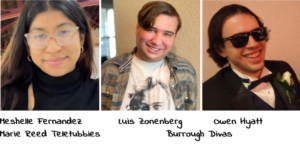Catholic University Hosts a 600 Year-Old Irish Chalice

Image Courtesy of Anna Harvey
By Anna Harvey
Students and faculty crowded into the pews of Caldwell Chapel for the 5:10 p.m. daily Mass. Yet this was no ordinary daily Mass. For the fourth time since its discovery, a fifteenth-century Irish chalice would be used in the sacrifice of the Mass.
Since the beginning of the semester, Catholic University has hosted the privately-owned chalice as the final stop on the chalice’s tour of Catholic institutions in the United States. Prior to the chalice’s arrival at Catholic University, Georgetown Prep and Villanova University held the artifact.
While the origins of the chalice are unknown, University Chaplain Fr. Aquinas said that the chalice’s private owner, “sees himself as a custodian, or steward of the chalice, not really its owner. He thinks that it should be enjoyed by others.”
While historians are unsure on how the chalice reemerged, it was rediscovered in England. While the chalice dates back to the fifteenth century, looters likely stole it during the Reformation in the seventeenth century.
On Tuesday, October 18, 2022 Catholic University held an event to reveal the chalice and inform students on its background in Irish history. The event began with a panel discussion from speakers Dr. Jennifer Paxton, Dr. Dony MacManus, Dr. Samuel Fisher, and Dr. Patrick Tuite.
As Director of the University Honors Program and a professor in the history department, Paxton gave a brief overview of the history of the Catholic Church in Ireland. She described that while Catholicism came to Ireland between the fourth and fifth centuries, it primarily grew out of monastic communities. Around the 12th century, the Irish Church began to organize itself as other religious orders such as the Augustinians entered the country. Yet, Paxton explained, after the English King Henry II invaded Ireland, he claimed to have a desire to reform the Irish Church. Instead, his actions resulted in divisions between the elite English Catholic community and the Irish Catholic community, which would linger for centuries and foster tensions between the ethnic communities.
Following Paxton, McManus spoke on the historic process of creating the silver chalice. As an independent artist and a professor in the Art department, McManus described how silversmiths formed the chalice from a sheet of silver that was heated, annealed, and quickly cooled. Following this process, the sheet of metal was placed on a leather cushion and beat to form the cup portion and base. Next, the silversmiths formed a silver tube to create the stem and poured bronze into a mold to make the decorative knob on the stem. McManus described how chalices today continue to be made with similar techniques.
Fisher briefly lectured on the tumult in Ireland during the Restoration and the seventeenth century. He described that during the Irish rebellion in Ulster in 1641, crimes committed by the Irish against the English and vice versa were often intentionally symbolic. Irish Catholics would burn Protestant English bibles and churches, and Protestants would sack Catholic churches and steal various objects. While the English government carefully documented crimes committed against Protestants, they dismissed crimes committed against Irish Catholics. Consequently, Fisher explained, when Oliver Cromwell invaded Ireland eight years later, he committed several massacres of Catholics and hunted down priests with ease. This period of unrest and violence in Ireland, he concluded, was likely when the Irish chalice was stolen or removed from its original, unknown church.
Lastly, as Associate Dean of Graduate Studies and Productions in the Rome school and founder of the CUA Irish Summer Institute, Tuite described several places and objects in Ireland that survived the violence of the Reformation. During his trips to Ireland with CUA students, Tuite visited the Malahide Castle, which was originally inhabited by the Catholic Talbot family and is well-known for its Flemish carvings. In addition to Malahide Castle, Tuite described two other notable historic objects surviving the Reformation: the statue of Our Lady of Dublin in Whitefriar Street Carmelite Church and a baptismal font in St. Audoen’s Church.
“I learned a lot about the history of the Irish church and how it was divided,” sophomore theology major Emily Louise Thomas said, “especially among religious orders. It’s surprising how one order would be divided between the Irish and English.”
Following the panel, Fr. Aquinas celebrated daily Mass in Caldwell Chapel with the historic chalice. As an altar server for the Mass, senior architecture major Jared Jagiello received the opportunity to hold the chalice.
“It was very cool to get to hold it,” Jagiello said. “It’s a lot lighter than it looks. You might think, ‘it’s silver, it’s heavy,’ but it’s as heavy as a paper clip.”
Tuite praised the craftsmanship of the chalice and discussed how many historic artifacts in Ireland have a storied history, with materials coming from various parts of Europe.
“I think it’s important to understand Irish history and the way that the Irish have maintained their faith over time, knowing the kind of adversity that they faced, some of the hardship that they dealt with, especially in the sixteenth and seventeenth centuries,” Tuite said. “So to have an object that survived that period, to be close to that makes it quite personal: so not only knowing Irish history, but also understanding your own faith through the example of others who were persecuted or suffered for their faith.”
“Despite whoever’s efforts to suppress the faith, to suppress the celebration of the Mass, the faith wins,” Fr. Aquinas said.







